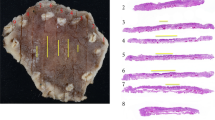Abstract
Conventional endoscopy can miss flat early gastric cancers (0-IIb) because they may not be visible. We treated a patient with synchronous flat early gastric cancers missed by conventional white-light endoscopy (WLE). A 74-year-old Japanese male was referred for endoscopic submucosal dissection (ESD) of a depressed-type early gastric cancer (0-IIc) on the posterior wall of the antrum. Linked color imaging (LCI) detected two flat reddish lesions (0-IIb) measuring 30 mm and 10 mm in diameter in the distal body and prepyloric area, respectively, which had not been detected by conventional WLE. LCI clearly demonstrated the line of demarcation between the malignant lesion and the surrounding mucosa without magnification. Flat early gastric cancers were suspected because both lesions had irregular surface patterns using magnifying blue laser imaging (BLI). An additional depressed lesion (0-IIc) was detected by laser WLE along the greater curvature in the antrum. Magnifying BLI suggested a malignant lesion. Histological examination of biopsy specimens revealed atypical glands in all four lesions. ESD of these lesions was performed. Pathological examination of the resected specimens confirmed well-differentiated adenocarcinoma localized to the mucosa in all four lesions. Flat early gastric cancers became clearly visible using new endoscopic technology.



Similar content being viewed by others
Abbreviations
- ESD:
-
Endoscopic submucosal dissection
- LCI:
-
Linked color imaging
- BLI:
-
Blue laser imaging
- NBI:
-
Narrow band imaging
- FICE:
-
Flexible spectral imaging color enhancement
References
Misumi A, Misumi K, Murakami A, et al. Endoscopic diagnosis of minute, small and flat early gastric cancers. Endoscopy. 1989;21:159–64.
Honmyo U, Misumi A, Murakami A, et al. Mechanism producing color change in flat early gastric cancers. Endoscopy. 1997;29:366–71.
Yao K, Yao T, Matsui T, et al. Hemoglobin content in intramucosal gastric carcinoma as a marker of histologic differentiation: a clinical application of quantitative electronic endoscopy. Gastrointest Endosc. 2000;52:241–5.
Osawa H, Yoshizawa M, Yamamoto H, et al. Optima band imaging system can facilitate detection of change in depressed type early gastric cancer. Gastrointest Endosc. 2008;67:226–34.
Osawa H, Yamamoto H. Present and future status of flexible spectral imaging color enhancement and blue laser imaging technology. Dig Endosc. 2014;suppl 1:105–15.
Yoshizawa M, Osawa H, Yamamoto H, et al. Diagnosis of elevated-type early gastric cancer by optimal band imaging system. Gastrointest Endosc. 2009;69:19–28.
Okada M, Sakamoto H, Takezawa T, et al. Laterally spreading tumor of the rectum delineated by linked color imaging technology. Clin Endosc. 2015 (in press).
Zaman A, Hahn M, Hapke R, et al. A randomized trial of peroral versus transnasal unsedated endoscopy using an ultrathin videoendoscope. Gastrointest Endosc. 1999;49:279–84.
Birkner B, Fritz N, Schatke W, et al. A prospective randomized comparison of unsedated ultrathin versus standard esophagogastroduodenoscopy in routine outpatient gastroenterology practice: does it work better through the nose? Endoscopy. 2003;35:647–51.
Faulx AL, Catanzaro A, Zyzanski S, et al. Patient tolerance and acceptance of unsedated ultrathin esophagoscopy. Gastrointest Endosc. 2002;55:620–3.
Mori M, Adachi Y, Kakeji Y, et al. Superficial flat-type early gastric carcinoma of the stomach. Cancer. 1992;69:306–13.
Osawa H, Yamamoto H, Miura Y, et al. Blue laser imaging provides excellent endoscopic images of upper gastrointestinal lesions. Video J Encycl GI Endosc. 2014;1:607–10.
Author information
Authors and Affiliations
Corresponding author
Ethics declarations
Conflict of Interest:
Hiroyuki Osawa received commercial research funding from Fuji film Medical Corporation and Takeda Pharmaceutical Company Limited. Author Hironori Yamamoto has a consultant relationship in FUJIFILM Corporation and has received honoraria, grants and royalties from the company.
Human/Animal Rights:
All procedures followed were in accordance with the ethical standards of the responsible committee on human experimentation (institutional and national) and with the Helsinki. Declaration of 1964 and its later amendments.
Informed Consent:
Informed consent was obtained from all patients for inclusion in the study.
Rights and permissions
About this article
Cite this article
Fukuda, H., Miura, Y., Hayashi, Y. et al. Linked color imaging technology facilitates early detection of flat gastric cancers. Clin J Gastroenterol 8, 385–389 (2015). https://doi.org/10.1007/s12328-015-0612-9
Received:
Accepted:
Published:
Issue Date:
DOI: https://doi.org/10.1007/s12328-015-0612-9




